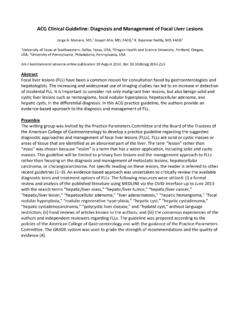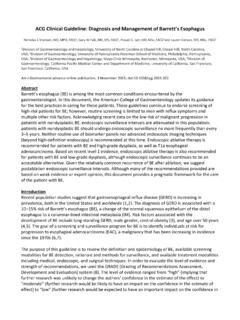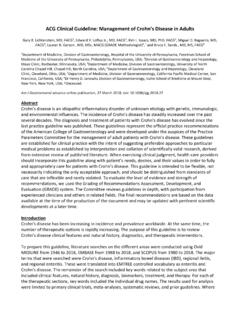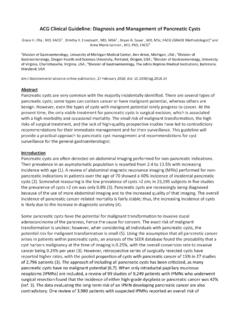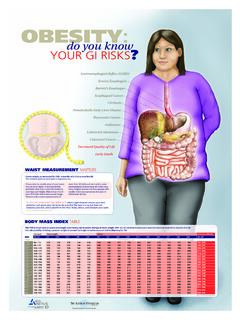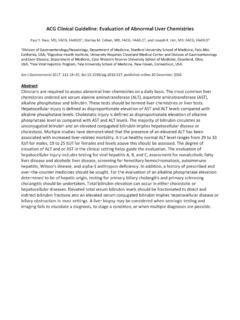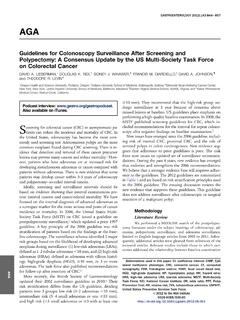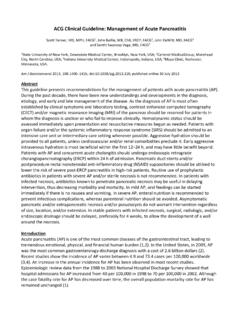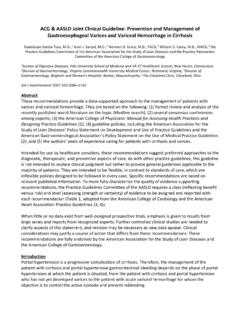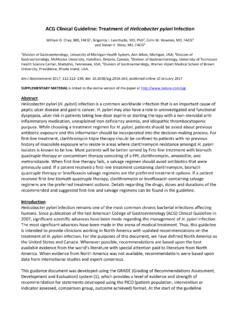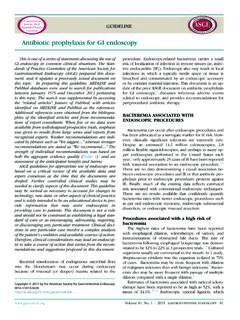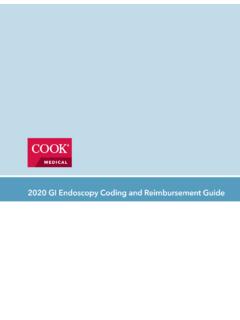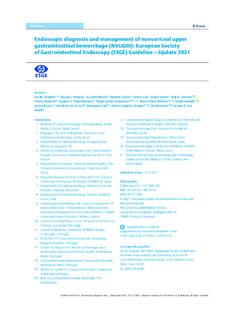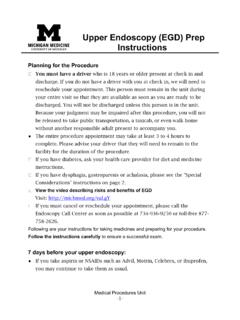Transcription of ACG Clinical Guideline: Management of Patients with Ulcer ...
1 ACG Clinical Guideline: Management of Patients with Ulcer Bleeding Loren Laine, MD1,2 and Dennis M. Jensen, MD3 5 1 Section of Digestive Diseases, Yale University School of Medicine, New Haven, Connecticut, USA; 2VA Connecticut Healthcare System, New Haven, Connecticut, USA; 3 David Geffen School of Medicine, University of California Los Angeles, Los Angeles, California, USA; 4 CURE Digestive Diseases Research Center, Los Angeles, California, USA; 5VA Greater Los Angeles Healthcare System, Los Angeles, California, USA.
2 Am J Gastroenterol 2012; 107:345 360; doi: ; published online 7 February 2012 Abstract This guideline presents recommendations for the step-wise Management of Patients with overt upper gastrointestinal bleeding. Hemodynamic status is first assessed, and resuscitation initiated as needed. Patients are risk-stratified based on features such as hemodynamic status, comorbidities, age, and laboratory tests. Pre-endoscopic erythromycin is considered to increase diagnostic yield at first endoscopy . Pre-endoscopic proton pump inhibitor (PPI) may be considered to decrease the need for endoscopic therapy but does not improve Clinical outcomes.
3 Upper endoscopy is generally performed within 24 h. The endoscopic features of ulcers direct further Management . Patients with active bleeding or non-bleeding visible vessels receive endoscopic therapy ( , bipolar electrocoagulation, heater probe, sclerosant, clips) and those with an adherent clot may receive endoscopic therapy; these Patients then receive intravenous PPI with a bolus followed by continuous infusion. Patients with flat spots or clean-based ulcers do not require endoscopic therapy or intensive PPI therapy.
4 Recurrent bleeding after endoscopic therapy is treated with a second endoscopic treatment; if bleeding persists or recurs, treatment with surgery or interventional radiology is undertaken. Prevention of recurrent bleeding is based on the etiology of the bleeding Ulcer . H. pylori is eradicated and after cure is documented anti- Ulcer therapy is generally not given. Nonsteroidal anti-inflammatory drugs (NSAIDs) are stopped; if they must be resumed low-dose COX-2-selective NSAID plus PPI is used. Patients with established cardiovascular disease who require aspirin should start PPI and generally re-institute aspirin soon after bleeding ceases (within 7 days and ideally 1 3 days).
5 Patients with idiopathic ulcers receive long-term anti- Ulcer therapy. Introduction Ulcers are the most common cause of hospitalization for upper gastrointestinal bleeding (UGIB), and the vast majority of Clinical trials of therapy for nonvariceal UGIB focus on Ulcer disease. This guideline provides recommendations for the Management of Patients with overt UGIB due to gastric or duodenal ulcers. "Overt" indicates that Patients present with symptoms of hematemesis, melena, and/or hematochezia. We first discuss the initial Management of UGIB in Patients without known portal hypertension, including initial assessment and risk stratification, pre-endoscopic use of medications and gastric lavage, and timing of endoscopy .
6 We then focus on the endoscopic and medical Management of Ulcer disease, including endoscopic findings and their prognostic implications, endoscopic hemostatic therapy, post-endoscopic medical therapy and disposition, and prevention of recurrent Ulcer bleeding. Each section of the document presents the key recommendations related to the section topic, followed by a summary of the supporting evidence. A summary of recommendations is provided in Table 1. A search of MEDLINE via the OVID interface using the MeSH term "gastrointestinal hemorrhage" limited to "all Clinical trials " and " meta-analysis " for years 1966 2010 without language restriction as well as review of Clinical trials and reviews known to the authors were performed for preparation of this document.
7 The GRADE system was used to grade the strength of recommendations and the quality of evidence (1). The quality of evidence, which influences the strength of recommendation, ranges from "high" (further research is very unlikely to change our confidence in the estimate of effect) to "moderate" (further research is likely to have an important impact on our confidence in the estimate of effect and may change the estimate) to "low" (further research is very likely to have an important impact on our confidence in the estimate of effect and is likely to change the estimate)
8 , and "very low" (any estimate of effect is very uncertain). The strength of a recommendation is graded as strong when the desirable effects of an intervention clearly outweigh the undesirable effects and is graded as conditional when uncertainty exists about the trade-offs (1). In addition to quality of evidence and balance between desirable and undesirable effects, other factors affecting the strength of recommendation include variability in values and preferences of Patients , and whether an intervention represents a wise use of resources (1).
9 Table 1. Summary and strength of recommendations Initial assessment and risk stratification 1. Hemodynamic status should be assessed immediately upon presentation and resuscitative measures begun as needed (Strong recommendation). 2. Blood transfusions should target hemoglobin >= 7 g/dl, with higher hemoglobins targeted in Patients with Clinical evidence of intravascular volume depletion or comorbidities, such as coronary artery disease (Conditional recommendation). 3. Risk assessment should be performed to stratify Patients into higher and lower risk categories and may assist in initial decisions such as timing of endoscopy , time of discharge, and level of care (Conditional recommendation).
10 4. Discharge from the emergency department without inpatient endoscopy may be considered in Patients with urea nitrogen < mg/dl; hemoglobin >= g/dl for men ( g/dl for women), systolic blood pressure >= 110 mm Hg; pulse < 100 beats / min; and absence of melena, syncope, cardiac failure, and liver disease, as they have < 1% chance of requiring intervention (Conditional recommendation). Pre-endoscopic medical therapy 5. Intravenous infusion of erythromycin (250 mg ~30 min before endoscopy ) should be considered to improve diagnostic yield and decrease the need for repeat endoscopy .
